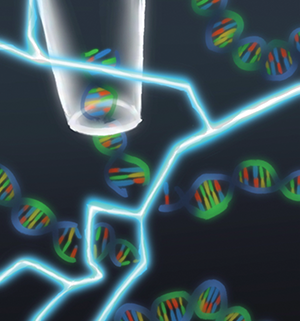

Scientists at the National Institute of Standards and Technology (NIST) have developed a new technology for measuring how radiation damages DNA molecules. This novel technique, which passes DNA through tiny openings called nanopores, detects radiation damage much faster and more accurately than existing methods. It could lead to improved radiation therapy for cancer and more personalised care for individuals during radiological emergencies.
“With nanopore sensing, we’re not just measuring radiation damage; we are rewriting the rules on how quickly and effectively we can respond to both cancer care and emergencies,” said NIST physical scientist, Joseph Robertson.
The research has now successfully completed the proof-of-concept phase, having been demonstrated in the laboratory using carefully prepared DNA in a test tube. Future plans involve developing a portable version of the technology and utilising the technique to measure radiation damage to DNA extracted from biological cells and tissues.
How the new technology works
Current methods for measuring the biological effects of radiation are slow and often ineffective at providing results when needed, particularly in medical and emergency situations. To assess radiation damage in an individual exposed to radiation, medical professionals take a blood sample and either count the number of dead cells (a process that takes at least two days) or culture cells from the sample to detect chromosomal abnormalities (which takes at least three days).
These existing techniques have a limited range and cannot measure doses above about 5 gray, which is lower than what an individual may be exposed to in a major radiological incident. A gray (Gy) is a unit that expresses the amount of radiation energy absorbed by the body or an object per kilogram of mass.
The method leverages the fact that ionising radiation, such as X-rays and gamma rays, breaks DNA into smaller fragments.
One of the key advantages of this technology is its potential portability. NIST researchers are collaborating with industry partners to develop a device that could be as small and affordable as a smartphone, making it easily accessible in hospitals, emergency response situations, and even field settings. In the coming years, researchers hope to partner with commercial entities to build a prototype device.
“This technology is not merely a leap forward; it is a lifeline,” said Robertson. “By making radiation measurement precise and accessible, we are striving to ensure that help is always within reach.”
For more information visit www.nist.gov

© Technews Publishing (Pty) Ltd | All Rights Reserved